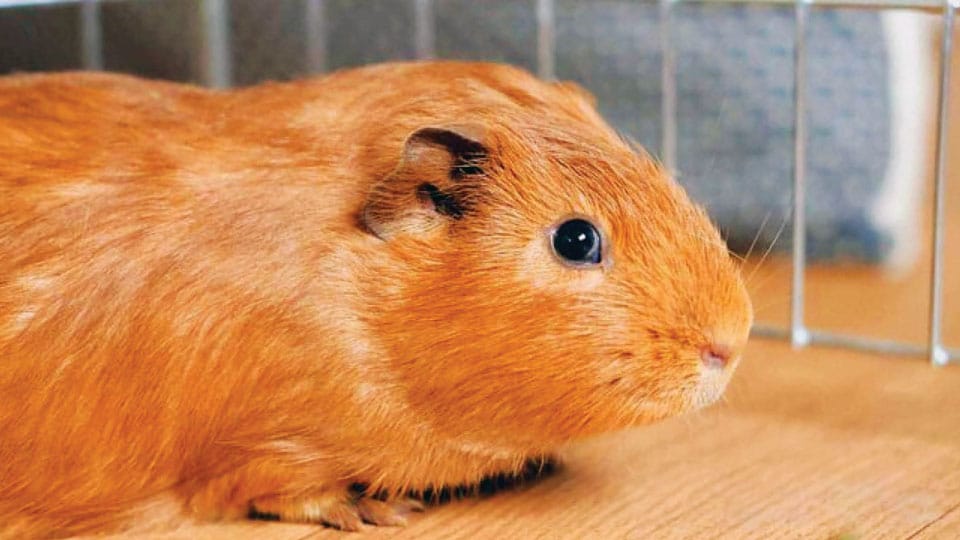In this week’s Pet Talk, Maneka tells how long should a guinea pig be in its cage and do they need exercise
By Maneka Gandhi
How often do you need to cut a guinea pig’s nails?
Guinea pig nails do not stop growing, so you will have to trim them once they get too long. If you don’t, the guinea pig’s feet will be in pain. Aim to clip your guinea pig’s nails at least once a month. As the nails get longer, the blood vessel, called the “quick”, gets longer too and the nails will start to curl.
What are some tips I should follow before getting a guinea pig?
There is also a lot to know about taking care of them, and if you make a mistake, your guinea pigs could get sick and die. Most guinea pigs do not live a full lifespan because people do not learn enough about them. Before committing to the idea of getting one, it is important to read books and have some idea what you are getting into.
A mistake that people make is not providing fresh food, and especially not enough leafy greens. Many guinea pigs get to eat nothing but hay and pellets, and can have a mineral imbalance because of it. Leafy greens are high in magnesium, whereas hay has a lot of calcium. These two minerals must be balanced, because guinea pigs need magnesium to utilise calcium. Too much calcium leads to problems like bladder stones, a horrible illness than kills many guinea pigs.
An ideal cage for a guinea pig should be at least two feet wide by three feet long. The cage’s floor space is important, because guinea pigs don’t make as much use of vertical space as other small rodents do. Do not use a wire bottom cage. The cage should have a solid bottom to avoid damage to their feet.
While glass aquariums and plastic tubs might meet the size requirements, they should be avoided, as they limit ventilation. The cage can be open top, or it can have a solid plastic bottom with a wire cage top. If open top, the cage should be at least 8-10 inches tall.
The best substrate is soft recycled paper products and newspaper. Provide 2-3 inches of bedding, so absorption is maximised.
To avoid contamination and to make sure the water stays clean, water should be offered in a drinking bottle instead of a water dish. The bottle must be monitored daily to ensure the pet is drinking and the water is not leaking, as guinea pigs are very prone to dehydration.
Do not bring a guinea pig into a house where you have cats and dogs as pets. The animal will be in huge stress and the chances of being killed is high. There is absolutely no point in simply locking it up in a cage.
What kind of a cage is recommended for a guinea pig?
While small animal cages often utilise vertical space to increase living area and encourage climbing, digging and burrowing, guinea pigs rely on floor space. Ramps and platforms at low heights provide variety, but guinea pigs need room to exercise, even with daily playtime outside of the cage.
The following guidelines are useful to determine the space needed for guinea pigs.
One guinea pig: 7.5 square feet cage (minimum), but more is better; generally 30” x 36” is a good size.
Two guinea pigs: 7.5 square feet (minimum), but 10.5 square feet is preferred; generally 30” x 50” is a good size.
Three guinea pigs: 10.5 square feet (minimum), but 13 square feet is preferred; generally 30” x 62” is a good size.
Four guinea pigs: 13 square feet (minimum), but more is better; generally 30” x 76” is a good size.
Larger enclosures are one of the most basic types of enrichment you can provide. Guinea pigs can live 5-7 years and can become bored and depressed without adequate stimulation. Imagine spending your whole life in a walk-in closet. Even with occasional breaks, life would be pretty dreary. Adequate room to exercise means that your guinea pigs are less likely to develop medical conditions such as heart disease, diabetes, bumble-foot, and anal impaction.
With a roomier enclosure, guinea pigs can exercise on their schedule, not yours. Guinea pigs tend to be most active in the morning and evening when it may not be convenient to take them out for playtime.
Larger areas increase the likelihood of peaceful co-existence among multiple guinea pigs (and since guinea pigs are social animals, they do best when housed together).
Larger spaces are actually easier to clean because they prevent the build-up of waste and allow guinea pigs to separate their bathroom area from other activities.
With the opportunity to express a wider range of natural behaviours, your guinea pigs will be happier and it will be easier to get to know their personalities.
How long should a guinea pig be in its cage? Do they need exercise?
Exercise is incredibly important for your guinea pigs. Not only does it keep them healthy and fit, but it also provides them with mental stimulation.
Guinea pigs need at least 1 hour of exercise each day. This can be as simple as allowing your guinea pig free-range time to burn off some steam. You should aim to give your guinea pig at least 1 hour of exercise each day, whether it’s free-range time or inside a run/playpen. For guinea pigs, who live in small habitats, 3-4 hours may be more ideal. Exercising guinea pigs isn’t as hard as it sounds. Providing your guinea pig with a run or playpen will be enough for your guinea pig to exercise in. Make sure the run is big enough for your guinea pig to move freely around in (at least 1.2 meters in length!). You should always supervise your guinea pig when they are in their run or playpen.
You could also use a room in your house to give your guinea pigs free-range time, which will count as exercise. The room must be guinea pig-proof, which means you should stash away any electrical wires, plastic, household plants, dangerous materials, or any other objects your guinea pig could potentially chew.
When letting your guinea pigs outside, make sure the weather is dry and the temperature is in their preferred range. If it has been raining recently, make sure the grass is completely dry before you allow your guinea pig outside. You should provide your guinea pig with an exercise run or playpen to run around in when they are outside. The enclosed area should be away from direct sunlight and loud noises. The exercise run or playpen should be sturdy and secure so your guinea pig cannot escape. It is recommended that the run/ playpen also has a top or cover.
How early should a calf receive colostrum?
Colostrum is protein rich first milk of cow. It should be received 30 minutes after the calf is born.
What are two common baby calf diseases?
All calves are exposed to a variety of micro-organisms such as viruses, bacteria and protozoa as soon as they are born. Three important disease problems for young calves are septicaemia, diarrhoea and pneumonia.
How long is a dairy cow’s gestation period?
Gestation length varies by age of the cow, breed, and sex of the calf. Gestation period in cattle ranges from 278 to 287 days. For most breeds, 283 days is common.
What is a sign that a heifer is coming into heat?
Heifers show certain symptoms. One of the most common symptoms is that they attempt to mount other animals.
If there are large numbers of flies around the cow barn, what should be the first thing to be examined in an attempt to solve the fly problem?
Check the manure handling procedures, check that nothing is getting decomposed near the barn and that the surrounding is properly cleaned. Sanitise the surroundings properly. Manure, filth, damp and dark corners, stagnant water etc. are all favourite breeding places of insects and flies and these places should be concentrated for removal and cleaning periodically.








Recent Comments